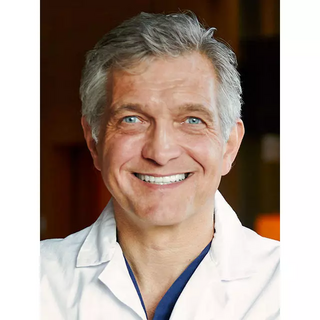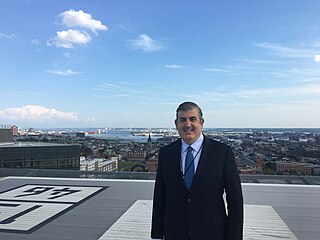
Neurosurgery or neurological surgery, known in common parlance as brain surgery, is the medical specialty concerned with the surgical treatment of disorders which affect any portion of the nervous system including the brain, spinal cord and peripheral nervous system.
The study of neurology and neurosurgery dates back to prehistoric times, but the academic disciplines did not begin until the 16th century. The formal organization of the medical specialties of neurology and neurosurgery are relatively recent, taking place in the place in Europe and the United States only in the 20th century with the establishment of professional societies distinct from internal medicine, psychiatry and general surgery. From an observational science they developed a systematic way of approaching the nervous system and possible interventions in neurological disease.
Tethered cord syndrome (TCS) refers to a group of neurological disorders that relate to malformations of the spinal cord. Various forms include tight filum terminale, lipomeningomyelocele, split cord malformations (diastematomyelia), occult, dermal sinus tracts, and dermoids. All forms involve the pulling of the spinal cord at the base of the spinal canal, literally a tethered cord. The spinal cord normally hangs loose in the canal, free to move up and down with growth, and with bending and stretching. A tethered cord, however, is held taut at the end or at some point in the spinal canal. In children, a tethered cord can force the spinal cord to stretch as they grow. In adults the spinal cord stretches in the course of normal activity, usually leading to progressive spinal cord damage if untreated. TCS is often associated with the closure of a spina bifida. It can be congenital, such as in tight filum terminale, or the result of injury later in life.
John A. Jane, Sr. was an American neurosurgeon, and Professor of Neurosurgery at the University of Virginia. He was Chairman of the Department of Neurosurgery at the University of Virginia from 1969 to 2006.
Joshua B. Bederson is an American neurosurgeon, Leonard I. Malis, MD/Corinne and Joseph Graber Professor of Neurosurgery, and System Chair of Neurosurgery at the Mount Sinai Health System in New York City. He is a Fellow of the American College of Surgeons, and an attending neurosurgeon at The Mount Sinai Hospital.
Andrew C. Hecht is an American orthopaedic surgeon and a nationally recognized leader in surgery on the spine.
The TESSYS method is a minimally-invasive, endoscopic spinal procedure for the treatment of a herniated disc. It was a further development of the YESS method by the Dutch Dr Thomas Hoogland in the Alpha Klinik in Munich in 1989 and was first called THESSYS. The procedure involves performing a small foramenotomy and removal of soft tissue compressing the nerve root.

Roger Härtl is an American neurological surgeon at Weill-Cornell Medical College and NewYork-Presbyterian Hospital. He is the Director of Spinal Surgery at the Weill Cornell Brain & Spine Center. Härtl has been named by Becker's Spine Review as one of the Top 50 Spine Surgeons in the United States as well as one of the Top 10 Spine and Neurosurgeon Leaders at Non-Profit Hospitals. He was named one of New York's Top Doctors by New York Magazine after he saved the life of New York firefighter Eugene Stolowski.

Nicholas Theodore is an American neurosurgeon and researcher at Johns Hopkins University School of Medicine. He is known for his work in spinal trauma, minimally invasive surgery, robotics, and personalized medicine. He is Director of the Neurosurgical Spine Program at Johns Hopkins and Co-Director of the Carnegie Center for Surgical Innovation at Johns Hopkins.

Michael L. J. Apuzzo is an American academic neurological surgeon, the Edwin M. Todd/Trent H. Wells, Jr. Professor Emeritus of Neurological Surgery and Radiation Oncology, Biology, and Physics at the Keck School of Medicine, of the University of Southern California. He is also editor emeritus of the peer-reviewed journals World Neurosurgery and Neurosurgery. He is distinguished adjunct professor of neurosurgery at the Yale School of Medicine, distinguished professor of advanced neurosurgery and neuroscience and senior advisor, at the Neurological Institute, Wexner Medical School, The Ohio State University, and adjunct professor of neurosurgery, Weill Cornell Medicine, Department of Neurological Surgery & Weill Cornell Brain and Spine Center.
Minimally invasive spine surgery, also known as MISS, has no specific meaning or definition. It implies a lack of severe surgical invasion. The older style of open-spine surgery for a relatively small disc problem used to require a 5-6 inch incision and a month in the hospital. MISS techniques utilize more modern technology, advanced imaging techniques and special medical equipment to reduce tissue trauma, bleeding, radiation exposure, infection risk, and decreased hospital stays by minimizing the size of the incision. Modern endoscopic procedures can be done through a 2 to 5 mm skin opening. By contrast, procedures done with a microscope require skin openings of approximately one inch, or more.
Curtis Dickman is an American researcher, author, and retired Neurosurgeon. He is recognized internationally for his pioneering work in the fields of Spinal Surgery, Surgery of the Craniocervical Junction, Spinal Biomechanics, and Thoracoscopic Neurosurgery.

Theodore H. Schwartz is an American medical scientist, academic physician and neurosurgeon.
Rob Dickerman is a neurological and spine surgeon from Plano, Texas, who has performed high-profile surgical procedures on professional athletes.
Richard Parkinson is an Australian neurosurgeon. Dr Parkinson is a leading Sydney neurosurgeon who has treated several high-profile sportspeople including NRL players, and champion horserider Darren Beadman.

Parviz Kambin was an American-Iranian medical doctor and orthopaedic surgeon. He was a Professor of Orthopaedic Surgery and has established an Endowed Chair of Spinal Surgery Research at Drexel University College of Medicine. He published more than 55 articles in peer-reviewed journals, edited two textbooks and contributed chapters in spinal surgery textbooks. He lectured worldwide in the field of minimally invasive spinal surgery. His research and development in this specialty began in 1970.
Isabelle M. Germano is a neurosurgeon and professor of neurosurgery, neurology, and oncology at the Icahn School of Medicine at Mount Sinai Hospital. She is a Fellow of the American College of Surgeons and the American Association of Neurological Surgeons. Germano works with image-guided brain and spine surgery.
Nazir Ahmad is a neurosurgeon from Pakistan who has made contributions to the field of neurosurgery, particularly in the modernization of neurosurgical practices. He has published over 60 research articles in the field of neurosurgery.
Richard N.W. Wohns is a neurosurgeon who is the founder and president of NeoSpine, LLC. He has been listed one of the 50 Spine Surgeons and Specialists to Know by Becker's ASC Review. He currently practices and teaches medicine in the Puget Sound Region of Washington, United States.
Gabriel Zada is Professor of Neurological Surgery at the University of Southern California. He is known for his expertise in brain tumor and pituitary tumor surgery and as an innovator in minimally invasive cranial surgery. Zada is the director of the USC Brain Tumor Center, USC Endoscopic Skull Base Surgery Program and USC Radiosurgery Center. He is also an NIH-funded principal investigator at the Zilkha Neurogenetic Institute. He specializes in endoscopic and minimally invasive neurosurgical techniques. During his career, he has published over 200 peer-reviewed articles on various neurosurgical topics, and holds numerous U.S. patents pertaining to minimally invasive neurosurgery and surgical devices.





